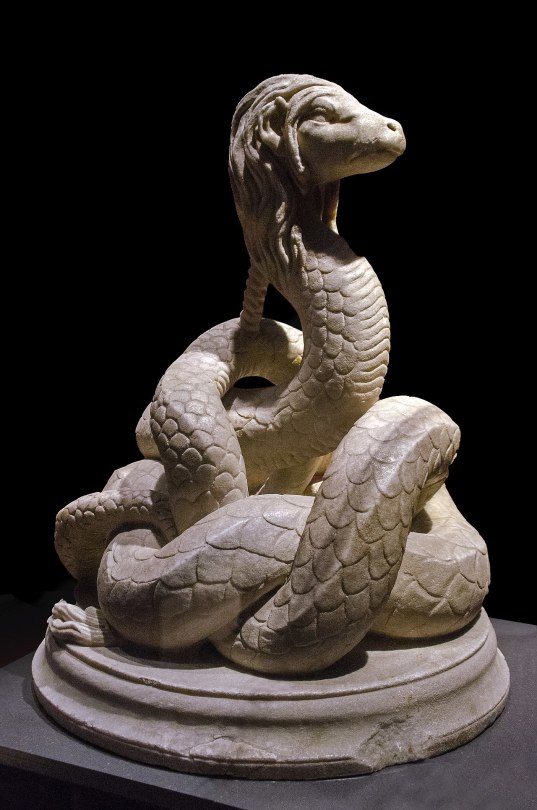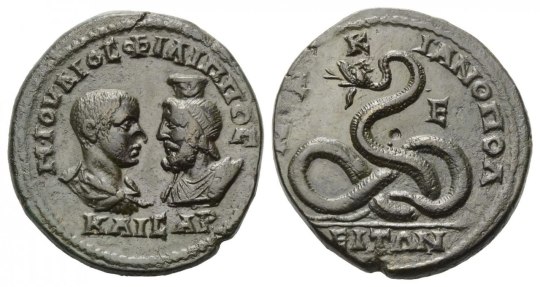#Alexander of Abonoteichos
Explore tagged Tumblr posts
Text

TO THE RAVENS
Alexandros the Peregrine, a dashing, cutting, irreverent prophet with a tame god.
When it comes to the inspiration for this character, that's easy: He's based on the real life prophet Alexander of Abonoteichos, the subject of Lucian's famous essay “Alexander the False Prophet”. But Lucian fans will also notice some references to Peregrinus, a lesser known but still colorful prophet whom Lucian also skewered on the end of his stylus. They're both interesting figures, and it was a lot of fun combining them into my Alexandros, the second most important character in the novel.
Read more to learn about this very pretty trickster.
Out of all of the characters, Alexandros most closely mirrors his real life counterpart (though even there, not very closely), so in that way he was an easy character to develop. And engrossing to research for. He's a false prophet who throws together his own religion. Religion as a subject fascinates me. Even before starting this project, I was pretty familiar with a number of niche religious movements, both those that would be considered cults and others that would more neutrally be called unique. So along with looking at Alexander of Abonoteichos' traits (as thoroughly criticized by Lucian), I also drew from these other references, though hopefully not too closely; I want the details of Alexandros' cult to ring true to real-world movements without sounding too derivative.
I think one of the things about Alexandros that required a lot of thought was setting the tone for his personality, the way he talks, the things he does, and overall his impact on those around him. On the one hand, we're talking about a cult. You can't realistically write about a cult and ignore how serious they are. But on the other hand, I still wanted to play around with humor. Religion – and I'm not writing this as any kind of skeptical or atheistic statement – is inherently funny. It's an important thing, and important things often have very funny elements to them, partially because of their very importance. According to Lucian, the real life Alexander made some extraordinarily ludicrous (and daring) gambles, and I wanted to play with that. Play with that, have fun with it. But – at the same time – you can never shut off your brain and pretend all of this is just funny.
As far as his design goes, Lucian tells us Alexander was handsome, even “godlike”. With my Alexandros, I decided to make his features almost uncannily ideal. We only ever see him directly in the heroine Akantha's pov, and when she meets him she's had very few men in her life who take her as seriously as Alexandros does, befriending her, caring about the things that hurt her, taking her into his secrets. So she's dazzled by him. It's arguable whether his dazzle is objective or comes more through her perception of him, but I do want him to have a beautiful, almost godlike quality at times.
I decided to throw in a small cheek scar. Sort of a permanent dimple, as well as a hint that at some point in his reckless and quicksilver past, things didn't go according to plan. It's supposed to be on his left cheek, though it appears on his right cheek on the book's back cover – I wanted to include it but he was facing to the right, so I'm guilty of a deliberate inconsistency.
I love writing Alexandros. My hope is that the reader finds him intriguing – perhaps funny and charming, perhaps perceptive and intelligent, perhaps some other things – and, above all, is never bored when he's on the page.
#ancient rome#ancient greece#writeblr#writers on tumblr#fantasy novel#original character#lucian of samosata#alexander of abonoteichos#alexandros the peregrine#meta#to the ravens
5 notes
·
View notes
Text

The Glykon Snake
The Glykon was an ancient snake god which had an influential cult within the Roman Empire in the 2nd century.
It was created by the prophet Alexander of Abonoteichos, who claimed it was a new incarnation of Asclepius.
Glykon was a snake with the features of a man on his face, including long, blond hair.
It seems that the snake was actually a puppet which appeared in the temple.
Much like earlier Macedonian snake centered cults, the focus of the worship at the temple was on fertility.
By 160, the worship of Glykon had spread beyond the Aegean and even the Emperor Marcus Aurelius sought prophesies from Alexander and his snake god.
Glykon worship was found throughout the vast area between the Danube and Euphrates.

Pentassarion issued under Roman emperor Philip II. in Marcianopolis.
Beginning late in the reign of Antoninus Pius and continuing into the 3rd century, official Roman coins were struck in honor of Glykon, attesting his popularity.
The cult continued for at least a hundred years after Alexander's death.

A marble statue of Glykon was found during an excavation under the former Pallas railway station in Constanța, Romania.
Currently, the statue is displayed at the Constanța History and Archaeology Museum.
#scultpure#art#history#dark academia#aesthetic#roman empire#ancient history#mythology#snake god#glykon snake#glykon#glycon#asclepius#museum#ancient#archeology#marcus aurelius#Alexander of Abonoteichos#constanța#romania#ancient culture#i saw it at the museum yesterday :)#light academia
91 notes
·
View notes
Text
The Algorithm pushed a video at me titled something like "The seven grossest things worshipped by people for some reason", and I was terribly disappointed to discover they meant in video games — because people have absolutely worshipped some gross things! Off the top of my head, there's:
Vertumnus (or Voltumna): the original god of Rome, a vegetation god of the city's primal swamp. He's emphasized, above and beyond other gods, as a shapeshifter; his main surviving myth is about how he turned himself into a repulsive and ancient old woman in order to seduce a dryad. From Ovid: "Vertumnus' hot kisses ill suit an old woman's disguise"
Priapus, Greek god of fertility, consistently portrayed as a misshapen, deformed man who is just swingin' pipe; in most depictions, his penis is actually the largest of his limbs
Sterquilinus, another early Roman god, considered possibly an aspect of Saturn, who is sometimes delicately described as the god of odors; his name comes from the Latin "stercus", which means manure — yes, this is the god of poop
Glycon, a serpent god worshipped by a large cult in second century Rome, and by Alan Moore today. Lucian wrote at the time that the Glycon cult was a grift by its prophet, Alexander of Abonoteichos, and that the vast and terrifying serpent that the cult was worshipping was, in fact, a hand puppet. (Moore says that that's exactly what makes Glycon a good god to worship, as he is "not likely to start believing that glove puppet created the universe or anything dangerous like that.")
Tokoyo-no-kami, a caterpillar enshrined in 644 CE by shaman Ōube-no-Ō, with the usual promises that if you gave the insect all your money, the poor would become rich and the old become young. Ōube-no-Ō was soon shut down by the local lord Hata-no-Kawakatsu, and the cult immediately switched to worshipping Kawakatsu; after all, what better proof of great divinity could there be than defeating Tokoyo-no-kami?
Ah Puch, Maya god of death, a decomposing corpse with exposed ribs and spine, and whose alternate title is Kisin, the Flatulent
The video mentioned, of course, Cthulhu, and there are people out there — mostly various flavors of chaos magicians and offshoots of the Church of Satan — who claim to worship the various Lovecraftian deities and aliens
(And of course there's that obscure deity that's somehow three people but only one god, who is explicitly beyond comprehension, who despite being omniscient, omnipotent, and omnibenevolent still created puppy cancer and fish that swim up your urethra, ordered such thorough genocides that even the victims' farm animals had to be killed, and will condemn you to eternal firey punishment if you don't worship — correctly — the person of him that he impregnated a 14 year old girl with.)
4 notes
·
View notes
Text

Marble statue of Glycon, an ancient snake god created as the new incarnation of Asclepius in the mid-2nd century by the Greek oracle Alexander of Abonoteichos.
National History and Archaeology Museum of Constanta, Romania.
1 note
·
View note